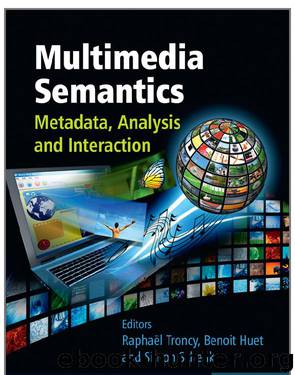Multimedia Semantics by Schenk Simon Troncy Raphael Huet Benoit & Benoit Huet & Simon Schenk

Author:Schenk, Simon, Troncy, Raphael, Huet, Benoit & Benoit Huet & Simon Schenk
Language: eng
Format: epub
Publisher: John Wiley & Sons
Published: 2011-07-06T16:00:00+00:00
9.4 Requirements for Designing a Multimedia Ontology
Requirements for designing a multimedia ontology have been gathered together and reported in the literature (Hunter and Armstrong 1999). Here, we compile these and use our scenario to present a list of requirements for a Web-compliant multimedia ontology.
MPEG-7 compliance. MPEG-7 is an existing international standard, used in both the signal processing and broadcasting communities. It contains a wealth of accumulated experience that needs to be included in a Web-based ontology. In addition, existing annotations in MPEG-7 should be easily expressible in our ontology.
Semantic interoperability. Annotations are only reusable when the captured semantics can be shared among multiple systems and applications. Obtaining similar results from reasoning processes about terms in different environments can only be guaranteed if the semantics is sufficiently explicitly described. A multimedia ontology has to ensure that the intended meaning of the captured semantics can be shared among different systems.
Syntactic interoperability. Systems are only able to share the semantics of annotations if there is a means of conveying this in some agreed syntax. Given that the (Semantic) Web is an important repository of both media assets and annotations, a semantic description of the multimedia ontology should be expressible in a Web language (e.g. OWL, RDF/XML or RDFa).
Separation of concerns. Clear separation of subject matter (i.e. knowledge about depicted entities, such as the person Ellen Scott) from knowledge that is related to the administrative management or the structure and the features of multimedia documents (e.g. Ellen's face is to the left of Mike's face) is required. Reusability of multimedia annotations can only be achieved if the connection between both ontologies is clearly specified by the multimedia ontology.
Modularity. A complete multimedia ontology can be very large, as demonstrated by MPEG-7. The design of a multimedia ontology should thus be made modular, to minimize the execution overhead when used for multimedia annotation. Modularity is also a good engineering principle.
Extensibility. While we intend to construct a comprehensive multimedia ontology, this can never be complete, as demonstrated by ontology development methodologies. New concepts will always need to be added to the ontology. This requires a design that can always be extended, without changing the underlying model and assumptions and without affecting legacy annotations.
Download
This site does not store any files on its server. We only index and link to content provided by other sites. Please contact the content providers to delete copyright contents if any and email us, we'll remove relevant links or contents immediately.
Grails in Action by Glen Smith Peter Ledbrook(9163)
Sass and Compass in Action by Wynn Netherland Nathan Weizenbaum Chris Eppstein Brandon Mathis(8808)
Azure Containers Explained by Wesley Haakman & Richard Hooper(7444)
Configuring Windows Server Hybrid Advanced Services Exam Ref AZ-801 by Chris Gill(7433)
Kotlin in Action by Dmitry Jemerov(7263)
Running Windows Containers on AWS by Marcio Morales(6984)
Microsoft 365 Identity and Services Exam Guide MS-100 by Aaron Guilmette(5402)
Microsoft Cybersecurity Architect Exam Ref SC-100 by Dwayne Natwick(5212)
Combating Crime on the Dark Web by Nearchos Nearchou(4982)
The Ruby Workshop by Akshat Paul Peter Philips Dániel Szabó and Cheyne Wallace(4671)
Management Strategies for the Cloud Revolution: How Cloud Computing Is Transforming Business and Why You Can't Afford to Be Left Behind by Charles Babcock(4527)
Python for Security and Networking - Third Edition by José Manuel Ortega(4233)
The Age of Surveillance Capitalism by Shoshana Zuboff(4209)
Learn Wireshark by Lisa Bock(4123)
The Ultimate Docker Container Book by Schenker Gabriel N.;(3888)
Learn Windows PowerShell in a Month of Lunches by Don Jones(3681)
DevSecOps in Practice with VMware Tanzu by Parth Pandit & Robert Hardt(3568)
Windows Ransomware Detection and Protection by Marius Sandbu(3543)
Blockchain Basics by Daniel Drescher(3507)
